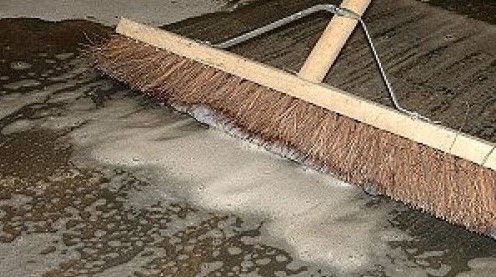How to prepare concrete floors for paints and coatings
New concrete should generally be left for 4 – 6 weeks before applying a paint or floor coating, although FixMaster Concrete Sealer and Dustproofer can be applied after only 7 days. Cement particles rise to the surface of concrete when laid and can prevent penetration and adhesion of the coating. Prepare the surface with FixMaster Acid Etch Cleaner to remove the cement particles or laitance and provide a key on very smooth surface.
It is essential that the alkalinity of new concrete is reduced prior to applying a floor coating, two applications of FixMaster Acid Etch Cleaner will help reduce alkalinity. Acid Etch Cleaner will also remove general dirt. Scrub the concrete using Acid Etch Cleaner and a stiff broom or scrubbing machine, flush with water and allow the concrete to dry. Vacuum shot blasting can be used to remove laitance and provide a key over large areas.
Often, a good sweep is enough to remove dirt/dust. FixMaster Acid Etch Cleaner can be used to remove dirt from bare concrete surfaces and provide a key on smooth surfaces. FixMaster Epoxy Prime 100 will help bind weak, very porous surfaces prior to applying an epoxy resin coating.

FixMaster Acid Etch
Most FixMaster coatings can be applied over existing paint, remove loose or defective paint. Well bonded paint can be over coated, smooth or shiny painted surfaces should be lightly abraded to provide a key although most existing painted surfaces are suitably abraded through wear and tear. Poorly bonded, flaking paint should be removed by grinding or shot blasting.
Most old painted floors include patches of bare concrete, it is not usually necessary to etch these patches with FixMaster Acid Etch Cleaner unless the concrete is very hard or smooth. We would recommend cleaning the entire area using FixMaster Bio Clean Degreser undiluted for heavy grease and oil removal (diluted with water by up to three times for light contamination). If one coat only is to be applied, we would recommend applying some of the paint to the exposed patches before applying one coat to the entire area.
Oil and grease can be removed using FixMaster Bio-Clean Degreaser. This product is extremely effective at lifting grease and oil out of concrete.
Most FixMaster coatings are for use on concrete and some precautions may be necessary if treating a screed.
1. Sand and cement screeds are generally weaker and more porous than concrete. Where two coats may suffice on concrete, three or four may be necessary to avoid a patchy finish on sand and cement. Do not acid etch sand and cement screeds, generally, they are very dusty and a good sweep will remove dirt. Apply the coating direct allowing for additional coats. Alternatively, apply one coat of FixMaster Concrete Sealer and Dustproofer to reduce porosity and then two coats of paint.
2. Granolithic screeds should be cleaned with FixMaster Bio Clean Degreaser and allowed to dry. Acid etching is ineffective. Vacuum shot blasting can be used to provide a key over large areas. Scarifying or grinding may be considered for small areas.
3. Latex screeds - we do not recommend that these are sealed or painted. If a rough floor does require smoothing before coating, see FixMaster Floor Leveller.

FixMaster Bio-Clean Degreaser
A surface should generally be slightly porous to allow penetration of a coating. If a surface has been sealed it is advisable to abrade the surface to form a key (vacuum shot blast large areas). If there is any doubt whether a surface has been sealed, splash some water onto the floor. If it soaks in, the surface is porous and can be painted,
If the surface ‘beads up’, abrasion may be necessary unless the surface is already well scuffed due to wear.
